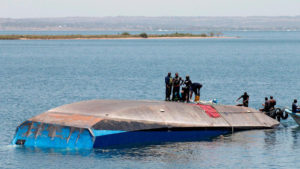by Ben Taylor
Over 200 dead in latest Lake Victoria ferry tragedy
The MV Nyerere, a ferry operating on Lake Victoria, capsized on September 20th. The Tanzanian government have declared that 228 people died as a result while 41 were rescued.
The ferry was running its route from Bugolora on Ukerewe Island to Bwisya on Ukara Island with passengers and a cargo of maize, bananas, and cement as well as a tractor. It went down in the afternoon, 50 metres from the dock of its intended destination.
Survivors said the man steering the vessel made a sharp turn after realising he was preparing to dock on the wrong side of the ship. With the ship close to docking, many passengers had congregated on one side of the boat, with the result that it was unbalanced and unable to cope with the sudden change of course. It keeled over wildly, righted itself, and capsized on the other side, throwing dozens of passengers – none of whom were wearing life jackets – into the lake. Most of those who drowned were trapped inside the upturned hull.
Originally, officials believed that the ferry may have been carrying more than 400 passengers, approximately four times the reported maximum capacity of the vessel. The precise number of passengers is unknown as the official responsible for dispensing tickets drowned and the machine that recorded the number of passengers was lost in the wreckage. A week after the incident, the government stated that “close to 270” passengers had been on board.
President John Magufuli declared four days of national mourning and ordered the arrest of “all those involved in the management of the ferry”.
The government formed an investigative team led by a former army general to establish the cause of the disaster. Subsequently, President Magufuli dissolved the board of directors of the Tanzania Electrical, Mechanical and Electronics Services Agency (TEMESA), which runs ferry services on Tanzania’s mainland, as well as the board of the transport regulator, the Surface and Marine Transport Regulatory Authority (SUMATRA).
Just one week earlier, on September 14th, the local MP, Joseph Mkundi (Chadema), had complained in parliament that he had repeatedly warned the government that the MV Nyerere was “malfunctioning” and in urgent need of repair. A government spokesperson responded that new engines had been fitted recently.
The day after the disaster, the Minister of Home Affairs, Kangi Lugola, warned people against spreading false information that might cause turmoil. President Magufuli later cautioned politicians not to take advantage of the situation to gain political popularity.
The tragedy has led to renewed calls to address overloading on passenger and cargo boats. Overloading is seen as being largely responsible both for this latest incident as well as previous Tanzanian ferry disasters, notably the sinking of the MV Bukoba on Lake Victoria in 1996 and the MV Spice Islander in the Indian Ocean in 2011, causing the loss of 892 and 1,573 lives respectively.
One commentator argued that “most commentaries miss the point when attributing blame for such disasters. Rather than focus on the culpability of those endangering lives by overloading vessels, they lament the lack of life boats or life jackets, untrained navigators, inadequate maintenance and so on. … The elementary starting point— that government agencies perform all the roles that affect the safety of passengers, and therefore share full responsibility for disasters when they happen—is carefully avoided.”
Pope Francis, the United Nations secretary-general, Russian President Vladimir Putin and a number of African leaders expressed shock and sorrow. “His Holiness Pope Francis expresses his heartfelt solidarity with those who mourn the loss of their loved ones and who fear for the lives of those still missing,” the condolence telegram said, according to the Vatican.
“Our deepest condolences to the families and loved ones of the victims of the Lake Victoria ferry accident. Our thoughts are with you. We cannot thank the rescuers enough,” said President Paul Kagame of Rwanda in a tweet.
The ferry did not sink and was righted a week after the disaster.

